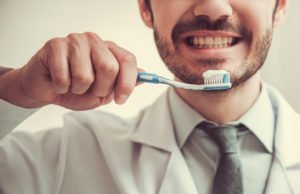4 Ways Toothpaste Enhances Brushing
 Brushing your teeth without any toothpaste can help your mouth a surprising amount. The brushing action alone scrapes away plaque and the bacteria that creates it loosens food particles and helps strengthen your gums by rubbing them. However, modern toothpaste has several ingredients that improve the effects of brushing your teeth, such as the following:
Brushing your teeth without any toothpaste can help your mouth a surprising amount. The brushing action alone scrapes away plaque and the bacteria that creates it loosens food particles and helps strengthen your gums by rubbing them. However, modern toothpaste has several ingredients that improve the effects of brushing your teeth, such as the following:
Abrasives
Did you ever wonder how polish works? Polish uses a very mild abrasive that scrapes away dirt, tarnish, and rust while leaving the metal underneath intact. If it feels smooth to the touch, that only goes to show just how mild the abrasive is. Toothpaste works the same way: tiny particles in the paste scrape away the plaque but don’t do any harm to the enamel, enhancing the effects of brushing.
Fluoride
Over half a century ago, medical researchers discovered that people who live in areas with a natural supply of fluoride in the water experience fewer cavities. Fluoride has a way of reversing the effect of enamel-eating bacteria, converting plaque and tartar back into the enamel. Fluoride isn’t a cure for tooth decay, but it can do a good job of slowing it down. That’s why most cities add a little fluoride to the water supply, and it’s why many types of toothpaste add a little fluoride to the formula.
Hydrogen Peroxide
Hydrogen peroxide is a common chemical used for disinfection and for bleaching everything from hair to clothes to teeth. Hydrogen peroxide is the most common active ingredient in tooth whitening products, and it’s usually what you’ll find in toothpaste that say they do the same thing. The chemical can be dangerous and make your teeth more sensitive if you use too much too often, but the amount found in toothpaste is small enough that you can safely use tooth-whitening pastes every day if you want.
Antibacterial Chemicals
Antibacterial chemicals include a large number of possible ingredients, but they all have the same function: they kill the bacteria in your mouth that creates plaque and causes gingivitis. This lets toothpaste do the same thing as a mouthwash rinse, although you may want to avoid toothpaste with these chemicals if you worry about them creating resistant forms of bacteria.
Other ingredients in toothpaste include sweeteners, humectants that maintain the paste’s consistency, and detergents that cause foaming. The foaming doesn’t do anything to help your teeth, but it does let you know that the toothpaste is working. Toothpaste companies produce many different formulas, so pick one that works for you and stick with it.